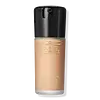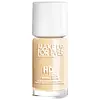Mac Cosmetics Studio Radiance Serum-Powered Foundation Versus Make Up For Ever HD Skin Hydra Glow Hydrating Foundation
What's inside
What's inside
 Key Ingredients
Key Ingredients

 Benefits
Benefits

 Concerns
Concerns

 Ingredients Side-by-side
Ingredients Side-by-side

Water
Skin ConditioningPhenyl Trimethicone
Skin ConditioningTricaprylin
MaskingGlycerin
HumectantButylene Glycol
HumectantC9-12 Alkane
SolventLauryl PEG-9 Polydimethylsiloxyethyl Dimethicone
Skin ConditioningOctyldodecanol
EmollientTrimethylsiloxysilicate
EmollientPolyglyceryl-2 Triisostearate
EmulsifyingOlea Europaea Fruit Oil
MaskingSimmondsia Chinensis Seed Oil
EmollientPPG-12/Smdi Copolymer
EmollientC12-15 Alkyl Benzoate
AntimicrobialPEG/PPG/Polybutylene Glycol-8/5/3 Glycerin
HumectantPolymethylsilsesquioxane
Sodium Hyaluronate
HumectantHydrolyzed Sodium Hyaluronate
Skin ConditioningHelianthus Annuus Seed Extract
Skin ConditioningCucumis Sativus Fruit Extract
EmollientTremella Fuciformis Sporocarp Extract
AntioxidantHordeum Vulgare Extract
EmollientTocopheryl Acetate
AntioxidantSorbitol
HumectantTrehalose
HumectantLecithin
EmollientDisteardimonium Hectorite
StabilisingOctyldodecyl Xyloside
EmulsifyingPropylene Glycol Dicaprate
EmollientPolyglyceryl-3 Diisostearate
EmulsifyingTriethyl Citrate
MaskingDisodium Stearoyl Glutamate
CleansingPvp
Emulsion StabilisingSilica
AbrasivePolysorbate 60
EmulsifyingSorbitan Isostearate
EmulsifyingBetaine
HumectantDimethicone
EmollientHdi/PPG/Polycaprolactone Crosspolymer
Synthetic Fluorphlogopite
Tin Oxide
AbrasivePEG-30 Dipolyhydroxystearate
EmulsifyingHydroxyethyl Acrylate/Sodium Acryloyldimethyl Taurate Copolymer
Emulsion StabilisingAluminum Dimyristate
Emulsion StabilisingCitric Acid
BufferingSilica Dimethicone Silylate
AbsorbentTriethoxycaprylylsilane
Hydroxyacetophenone
AntioxidantBHT
AntioxidantDisodium EDTA
Caprylyl Glycol
EmollientSodium Dehydroacetate
PreservativePotassium Sorbate
PreservativePhenoxyethanol
PreservativeCI 77891
Cosmetic ColorantCI 77492
Cosmetic ColorantCI 77491
Cosmetic ColorantCI 77499
Cosmetic ColorantWater, Phenyl Trimethicone, Tricaprylin, Glycerin, Butylene Glycol, C9-12 Alkane, Lauryl PEG-9 Polydimethylsiloxyethyl Dimethicone, Octyldodecanol, Trimethylsiloxysilicate, Polyglyceryl-2 Triisostearate, Olea Europaea Fruit Oil, Simmondsia Chinensis Seed Oil, PPG-12/Smdi Copolymer, C12-15 Alkyl Benzoate, PEG/PPG/Polybutylene Glycol-8/5/3 Glycerin, Polymethylsilsesquioxane, Sodium Hyaluronate, Hydrolyzed Sodium Hyaluronate, Helianthus Annuus Seed Extract, Cucumis Sativus Fruit Extract, Tremella Fuciformis Sporocarp Extract, Hordeum Vulgare Extract, Tocopheryl Acetate, Sorbitol, Trehalose, Lecithin, Disteardimonium Hectorite, Octyldodecyl Xyloside, Propylene Glycol Dicaprate, Polyglyceryl-3 Diisostearate, Triethyl Citrate, Disodium Stearoyl Glutamate, Pvp, Silica, Polysorbate 60, Sorbitan Isostearate, Betaine, Dimethicone, Hdi/PPG/Polycaprolactone Crosspolymer, Synthetic Fluorphlogopite, Tin Oxide, PEG-30 Dipolyhydroxystearate, Hydroxyethyl Acrylate/Sodium Acryloyldimethyl Taurate Copolymer, Aluminum Dimyristate, Citric Acid, Silica Dimethicone Silylate, Triethoxycaprylylsilane, Hydroxyacetophenone, BHT, Disodium EDTA, Caprylyl Glycol, Sodium Dehydroacetate, Potassium Sorbate, Phenoxyethanol, CI 77891, CI 77492, CI 77491, CI 77499
Water
Skin ConditioningCitrus Limon Fruit Extract
MaskingDicaprylyl Carbonate
EmollientPolyglyceryl-2 Dipolyhydroxystearate
Skin ConditioningC13-15 Alkane
SolventIsododecane
EmollientPropanediol
SolventGlycerin
HumectantPolyglyceryl-3 Diisostearate
EmulsifyingPentylene Glycol
Skin ConditioningHeptyl Undecylenate
EmollientSynthetic Fluorphlogopite
Simmondsia Chinensis Seed Oil
EmollientSodium Chloride
MaskingC18-21 Alkane
SolventStearalkonium Hectorite
Gel FormingUndecane
EmollientCocos Nucifera Fruit Extract
EmollientTridecane
PerfumingPersea Gratissima Oil
Skin ConditioningTocopheryl Acetate
AntioxidantDimethicone/Vinyl Dimethicone Crosspolymer
Skin ConditioningSodium Dehydroacetate
PreservativePropylene Carbonate
SolventTriethoxysilylethyl Polydimethylsiloxyethyl Hexyl Dimethicone
Skin ConditioningParfum
MaskingSodium Phytate
Citric Acid
BufferingHydrogen Dimethicone
Sodium Hydroxide
BufferingAlgin
MaskingGalactoarabinan
Levulinic Acid
PerfumingSodium Hyaluronate
HumectantPotassium Sorbate
PreservativeSodium Levulinate
Skin ConditioningTocopherol
AntioxidantMaltodextrin
AbsorbentBiosaccharide Gum-1
HumectantCI 77891
Cosmetic ColorantCI 77491
Cosmetic ColorantCI 77492
Cosmetic ColorantCI 77499
Cosmetic ColorantWater, Citrus Limon Fruit Extract, Dicaprylyl Carbonate, Polyglyceryl-2 Dipolyhydroxystearate, C13-15 Alkane, Isododecane, Propanediol, Glycerin, Polyglyceryl-3 Diisostearate, Pentylene Glycol, Heptyl Undecylenate, Synthetic Fluorphlogopite, Simmondsia Chinensis Seed Oil, Sodium Chloride, C18-21 Alkane, Stearalkonium Hectorite, Undecane, Cocos Nucifera Fruit Extract, Tridecane, Persea Gratissima Oil, Tocopheryl Acetate, Dimethicone/Vinyl Dimethicone Crosspolymer, Sodium Dehydroacetate, Propylene Carbonate, Triethoxysilylethyl Polydimethylsiloxyethyl Hexyl Dimethicone, Parfum, Sodium Phytate, Citric Acid, Hydrogen Dimethicone, Sodium Hydroxide, Algin, Galactoarabinan, Levulinic Acid, Sodium Hyaluronate, Potassium Sorbate, Sodium Levulinate, Tocopherol, Maltodextrin, Biosaccharide Gum-1, CI 77891, CI 77491, CI 77492, CI 77499
 Reviews
Reviews

Ingredients Explained
These ingredients are found in both products.
Ingredients higher up in an ingredient list are typically present in a larger amount.
Ci 77491 is also hydrated iron III oxide. It's sole purpose is to give a red/pink hue to products.
Iron III oxides are classified as inorganic chemicals for coloring.
Synthetically created Ci 77491 is considered safer than those naturally found. This is because the synthetically created version may contain less impurities. Iron oxides are generally non-toxic and non-allergenic.
Learn more about CI 77491Ci 77492 is also hydrated iron III oxide. It's sole purpose is to give a yellow hue to products.
Iron III oxides are classified as inorganic chemicals for coloring.
Synthetically created Ci 77492 is considered safer than those naturally found. This is because the synthetically created version may contain less impurities. Iron oxides are generally non-toxic and non-allergenic.
Learn more about CI 77492Ci 77499 is also hydrated iron III oxide. It is created from mixing red and black iron oxides. This helps give shades of darkness to a product.
Iron III oxides are classified as inorganic chemicals for coloring.
Ci 77891 is a white pigment from Titanium dioxide. It is naturally found in minerals such as rutile and ilmenite.
It's main function is to add a white color to cosmetics. It can also be mixed with other colors to create different shades.
Ci 77891 is commonly found in sunscreens due to its ability to block UV rays.
Learn more about CI 77891Citric Acid is an alpha hydroxy acid (AHA) naturally found in citrus fruits like oranges, lemons, and limes.
Like other AHAs, citric acid can exfoliate skin by breaking down the bonds that hold dead skin cells together. This helps reveal smoother and brighter skin underneath.
However, this exfoliating effect only happens at high concentrations (20%) which can be hard to find in cosmetic products.
Due to this, citric acid is usually included in small amounts as a pH adjuster. This helps keep products slightly more acidic and compatible with skin's natural pH.
In skincare formulas, citric acid can:
While it can provide some skin benefits, research shows lactic acid and glycolic acid are generally more effective and less irritating exfoliants.
Most citric acid used in skincare today is made by fermenting sugars (usually from molasses). This synthetic version is identical to the natural citrus form but easier to stabilize and use in formulations.
Read more about some other popular AHA's here:
Learn more about Citric AcidGlycerin is already naturally found in your skin. It helps moisturize and protect your skin.
A study from 2016 found glycerin to be more effective as a humectant than AHAs and hyaluronic acid.
As a humectant, it helps the skin stay hydrated by pulling moisture to your skin. The low molecular weight of glycerin allows it to pull moisture into the deeper layers of your skin.
Hydrated skin improves your skin barrier; Your skin barrier helps protect against irritants and bacteria.
Glycerin has also been found to have antimicrobial and antiviral properties. Due to these properties, glycerin is often used in wound and burn treatments.
In cosmetics, glycerin is usually derived from plants such as soybean or palm. However, it can also be sourced from animals, such as tallow or animal fat.
This ingredient is organic, colorless, odorless, and non-toxic.
Glycerin is the name for this ingredient in American English. British English uses Glycerol/Glycerine.
Learn more about GlycerinPolyglyceryl-3 Diisostearate is an emulsifer and emollient. It comes from Isostearic Acid and Polyglycerin-3.
As an emulsifier, it helps stabilize products by preventing oils and water from separating.
This ingredient may not be Malassezia folliculitis, or fungal acne safe.
Learn more about Polyglyceryl-3 DiisostearatePotassium Sorbate is a preservative used to prevent yeast and mold in products. It is commonly found in both cosmetic and food products.
This ingredient comes from potassium salt derived from sorbic acid. Sorbic acid is a natural antibiotic and effective against fungus.
Both potassium sorbate and sorbic acid can be found in baked goods, cheeses, dried meats, dried fruit, ice cream, pickles, wine, yogurt, and more.
You'll often find this ingredient used with other preservatives.
Learn more about Potassium SorbateThis oil comes from the seeds of the desert shrub called Jojoba. It is more commonly known as jojoba oil, a non-comedogenic oil.
Jojoba oil does not contain fragrance and has many fatty-acids, making it a great soothing ingredient.
It also contains Vitamin E, a great moisturizing ingredient. Vitamin E is also an antioxidant and protects your skin against oxidative damage.
This ingredient humectant properties, meaning it helps draw moisture from the air. This helps keep your skin hydrated.
While jojoba has antibacterial properties, it is only able to kill some strains of bacteria.
Studies also show it helps in wound healing. In fact, Indigenous cultures have used jojoba as a moisturizer and to help treat burns for centuries.
Fun fact: Jojoba oil similar to natural human skin sebum, so it has a great effect on dry skin. It is also promising with helping to regulate sebum production.
Due to its fatty acid content, Jojoba oil may not be fungal acne safe. We recommend speaking with a professional if you have any concerns.
Learn more about Simmondsia Chinensis Seed OilThis ingredient is a preservative with antimicrobial properties. It is the sodium salt of dehydroacetic acid.
It is especially effective at preventing bacterial and fungal growth in low concentrations.
Sodium Hyaluronate is hyaluronic acid's salt form. It is commonly derived from the sodium salt of hyaluronic acid.
Like hyaluronic acid, it is great at holding water and acts as a humectant. This makes it a great skin hydrating ingredient.
Sodium Hyaluronate is naturally occurring in our bodies and is mostly found in eye fluid and joints.
These are some other common types of Hyaluronic Acid:
Learn more about Sodium HyaluronateSynthetic Fluorphlogopite is the synthethic version of mica. It consists of fluorine, aluminum and silicate.
Synthetic Fluorphlogopite is used to add volume to products.
It is considered non-irritating on the skin.
Learn more about Synthetic FluorphlogopiteTocopheryl Acetate is AKA Vitamin E. It is an antioxidant and protects your skin from free radicals. Free radicals damage the skin by breaking down collagen.
One study found using Tocopheryl Acetate with Vitamin C decreased the number of sunburned cells.
Tocopheryl Acetate is commonly found in both skincare and dietary supplements.
Learn more about Tocopheryl AcetateWater. It's the most common cosmetic ingredient of all. You'll usually see it at the top of ingredient lists, meaning that it makes up the largest part of the product.
So why is it so popular? Water most often acts as a solvent - this means that it helps dissolve other ingredients into the formulation.
You'll also recognize water as that liquid we all need to stay alive. If you see this, drink a glass of water. Stay hydrated!
Learn more about Water